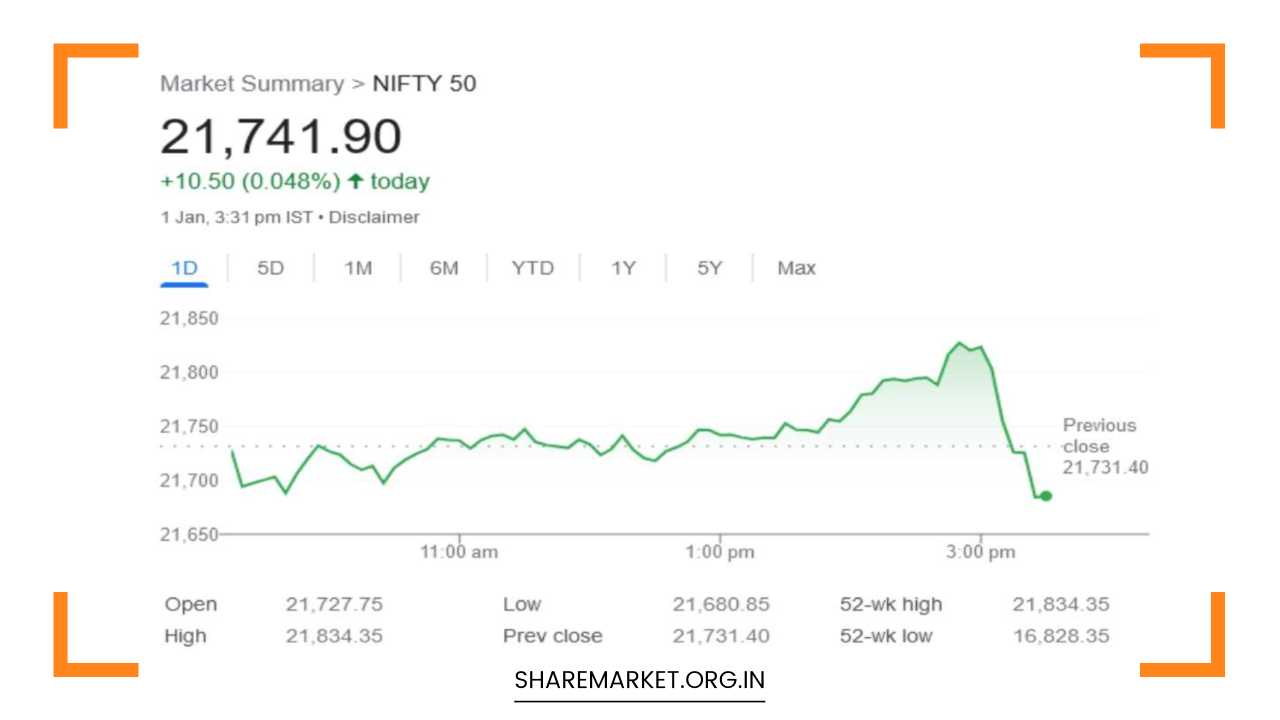Profit Booking Seen in the Market Today; Nifty Prediction for Tomorrow

Nifty Prediction for Tomorrow
Market Analysis: Bullish Trends, Profit Booking, and Outlook for January 2, 2024
The stock market has been experiencing a bullish trend recently, attributed to a cut in interest rates, a reduction in global inflation, and a softening of bond yields.
Despite the overall positive sentiment, profit booking has been observed at upper levels, contributing to a somewhat flat closing for Indian benchmark indices on January 1, 2024.
This analysis delves into the specific market movements, notable gainers and losers, sectoral performance, and expert opinions on the potential trajectory for January 2, 2024.
Market Performance on January 1, 2024:
In a highly volatile trading session, Indian benchmark indices closed with a slight gain on January 1, 2024. Profit booking ensued after a record rise in the market, causing the Sensex-Nifty to slip from the upper levels.
However, the indices managed to close with marginal gains. Notable gainers on Nifty included Nestle India, Adani Enterprises, Adani Ports, Tech Mahindra, and Wipro. Conversely, Eicher Motors, Bharti Airtel, M&M, Bajaj Auto, and HDFC Bank emerged as the top losers.
Analyzing the performance of sectoral indices, healthcare, FMCG, oil and gas, and PSU banks closed in the green, while some selling pressure was observed in the auto and banking sectors. Broader indices outperformed the Sensex-Nifty, with BSE Midcap and Smallcap each rising by 0.5 percent.
At the close of the trading day, the Sensex recorded a marginal gain of 31.68 points or 0.04 percent, closing at 72,271.94.
The Nifty, too, exhibited a modest increase of 10.50 points or 0.05 percent, concluding at 21,741.90. The market dynamics revealed that 2394 shares experienced an increase, 1015 shares witnessed a decline, and 107 shares remained unchanged.
Expert Insights and Projections for January 2, 2024:
Market analysts provided valuable insights into the potential trajectory of the market on January 2, 2024, considering the prevailing conditions.
Rupak Dey of LKP Securities emphasized the volatility in the Nifty throughout the trading session, reflecting a sense of indecision among traders.
On the hourly chart, Nifty temporarily fell below the 20 EMA intraday but managed to close in the green. Dey suggested that if Nifty slips below 21,650, it could weaken further. Conversely, a successful close above 21,750 might provide the market with additional momentum.
Aditya Gaggar, Director of Progressive Shares, observed that the market initiated the new year at a slow pace.
However, gains led by PSU banks and IT stocks helped the index recover losses. He noted that mid and small caps extended their morning gains, outperforming the frontline indices.
The daily chart of Nifty revealed the formation of a Gravestone Doji candlestick pattern, signaling a sell signal at upper levels.
The possibility of bearish divergence persisted, and if confirmed, a correction to Rs 21,500 could be anticipated. On the upside, if Nifty demonstrates strength by surpassing 21,800, it might pave the way for further upward movement.
Vinod Nair of Geojit Financial Services shed light on the overall bullish environment attributed to the cut in interest rates, a decline in global inflation, and softening bond yields.
However, he highlighted concerns about global supply chains due to the actions of Houthi terrorists in the Red Sea, prompting profit booking.
Factors Affecting Market Sentiment:
The bullish trend in the market is primarily influenced by three key factors: a cut in interest rates, a reduction in global inflation, and a softening of bond yields.
These factors collectively create a positive environment for investors, encouraging increased participation in the market.
Lower interest rates make borrowing more affordable for businesses and individuals, stimulating economic activity.
Global inflation trends play a crucial role in shaping market sentiment. A decrease in inflation rates implies greater purchasing power for consumers and lower input costs for businesses, contributing to economic growth.
Additionally, softening bond yields make equities more attractive compared to fixed-income securities, driving funds into the stock market.
However, despite the overall bullish sentiment, profit booking has been observed at upper levels. This phenomenon occurs when investors sell their assets to lock in profits after a significant market upswing.
Profit booking serves as a natural corrective mechanism, preventing excessive speculation and helping to maintain market stability.
Concerns and Challenges:
Amid the positive market trends, concerns have arisen regarding global supply chains due to the actions of Houthi terrorists in the Red Sea.
The geopolitical tensions and potential disruptions to supply chains could have ramifications for various sectors, influencing investor confidence and market dynamics.
Additionally, market participants are keenly watching the Federal Open Market Committee (FOMC) minutes for insights into potential interest rate cuts in 2024. The FOMC’s decisions and statements can significantly impact market expectations and influence investor behavior.
Sectoral Performance:
A closer look at sectoral indices reveals divergent trends. Healthcare, FMCG, oil and gas, and PSU banks closed in the green, indicating strength in these sectors.
On the other hand, some selling pressure was witnessed in the auto and banking sectors, contributing to a mixed performance across different industries.
The resilience of healthcare and FMCG sectors suggests a defensive stance adopted by investors, seeking stability and consistent returns in uncertain market conditions. Oil and gas, often influenced by global geopolitical factors, demonstrated strength, while PSU banks benefited from the overall positive sentiment.
The auto and banking sectors, facing selling pressure, may be influenced by specific challenges or concerns unique to these industries.
Auto stocks, for instance, might be affected by supply chain disruptions and global economic uncertainties. Banking stocks, on the other hand, could be responding to factors such as regulatory changes or macroeconomic trends.
Broader Indices and Market Breadth:
Broader indices, represented by BSE Midcap and Smallcap, outperformed the benchmark indices (Sensex-Nifty) by each rising 0.5 percent.
This outperformance suggests a broader market participation, with mid and small-cap stocks contributing significantly to the positive momentum.
The market breadth, measured by the ratio of advancing to declining stocks, further illustrates the widespread nature of the market movement.
While 2394 stocks experienced an increase, 1015 witnessed a decline, and 107 remained unchanged. The positive breadth indicates that a substantial number of stocks across various segments participated in the upward movement.
Conclusion and Outlook:
In conclusion, the stock market’s bullish trend, driven by a cut in interest rates, reduced global inflation, and softened bond yields, has set a positive tone for investors.
However, profit booking at upper levels, influenced by concerns over global supply chains, highlights the need for caution.
Geopolitical tensions and potential disruptions, as well as uncertainties related to the FOMC’s future actions, add complexity to the market dynamics.
Expert opinions suggest a cautious approach, considering the volatility and the potential for corrections. Traders are closely monitoring key levels, such as Nifty slipping below 21,650 or closing above 21,750, to gauge the market’s strength or weakness.
The formation of a Gravestone Doji candlestick pattern on the daily chart indicates a possible sell signal at upper levels, with the prospect of bearish divergence leading to a correction.
As the market moves into January 2, 2024, investors will be keenly watching for developments in global geopolitical situations, FOMC minutes, and any other factors that might influence market sentiment.
The resilience of mid and small-cap stocks, coupled with the performance of defensive sectors like healthcare and FMCG, could provide insights into the market’s overall health and potential directions in the coming days.

















